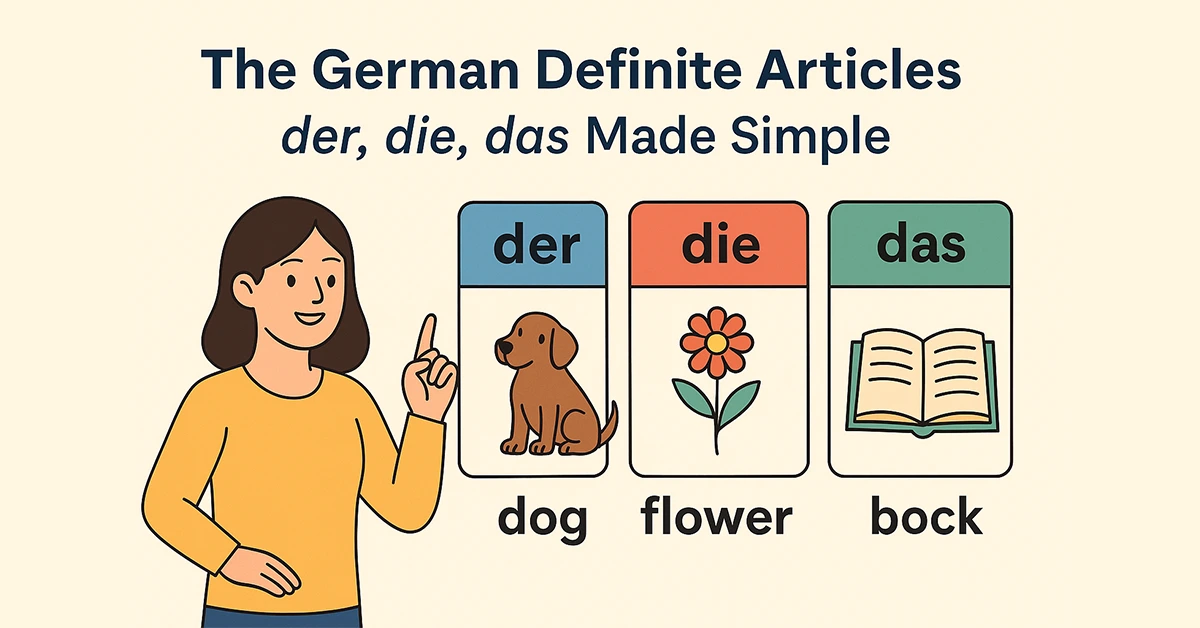The German Definite Articles: der, die, das Made Simple

Master the German definite articles der, die, das with rules, tables, and clear examples. Learn gender and case usage easily.
What Are Definite Articles in German?
Definite articles in German – der, die, and das – are used to refer to specific nouns. They correspond to “the” in English.
Why Are Articles Important in German Grammar?
Articles in German show the gender, number, and case of a noun. They are essential for correct sentence structure and comprehension.
When to Use “der,” “die,” and “das”
- der – masculine nouns
- die – feminine nouns
- das – neuter nouns
Example: der Hund (the dog), die Katze (the cat), das Buch (the book)
How to Identify the Right Article for a Noun
Use dictionaries, memorize common patterns (e.g., nouns ending in -ung are usually feminine), or rely on gender-coded flashcards.
German Noun Gender and Definite Articles
| Gender | Article | Example |
|---|---|---|
| Masculine | der | der Tisch (the table) |
| Feminine | die | die Blume (the flower) |
| Neuter | das | das Auto (the car) |
Definite Articles and Plural Forms
All plural nouns take die regardless of gender. Example: die Hunde (the dogs), die Autos (the cars).
German Definite Articles by Case
| Case | Masculine | Feminine | Neuter | Plural |
|---|---|---|---|---|
| Nominative | der | die | das | die |
| Accusative | den | die | das | die |
| Dative | dem | der | dem | den |
| Genitive | des | der | des | der |
Definite Articles with Prepositions
Some prepositions change the case, which affects the article. Example: mit dem Auto (with the car), für die Frau (for the woman)
Definite Articles in Compound Nouns
In compound nouns, the article depends on the last word. Example: das Haus + die Tür = die Haustür (the front door)
Definite Articles in Context: Formal vs Informal Usage
In formal texts, articles are used more strictly. In informal speech, sometimes they are dropped, especially in idiomatic expressions like zu Hause.
Examples of Definite Articles in Sentences
- Der Mann liest ein Buch. (The man is reading a book.)
- Ich sehe die Frau. (I see the woman.)
- Das Kind spielt im Garten. (The child is playing in the garden.)
Definite Articles in Everyday German
You hear der, die, das everywhere – in menus, signs, conversations. Recognizing them in context helps retention.
Using Definite Articles with Names and Places
Some countries and geographical names use articles: die Schweiz (Switzerland), der Iran, das Ruhrgebiet.
Tips to Remember der, die, das Easily
- Use color-coded flashcards (e.g., blue for masculine).
- Group words by gender when studying.
- Repeat them in full phrases.
Visual Tricks and Mnemonics for der/die/das
Imagine a dog for der, a flower for die, and a book for das. Connect the image with the noun every time.
Common Mistakes with German Definite Articles
Don’t guess the article from English! “Girl” is neuter in German: das Mädchen. Learn gender with the noun.
How to Correct Your Article Usage Over Time
Practice speaking and writing with corrections. Use grammar apps and highlight article mistakes in your writing.
Practice: Quiz Yourself on der, die, das
- What’s the article for “Tisch”? (Answer: der)
- What case is used after “mit”? (Answer: Dative → mit dem Freund)
- What’s the plural of “das Auto”? (Answer: die Autos)
Frequently Asked Questions About German Definite Articles
Is there a trick to always know the article?
No foolproof trick exists, but patterns, colors, and repetition help a lot.
Why is “Mädchen” neuter?
Because it ends in -chen, a diminutive suffix that is always neuter in German.
Conclusion: Mastering Definite Articles in German
Don’t try to memorize everything at once. Use daily exposure, context learning, and spaced repetition to make der, die, das second nature.